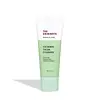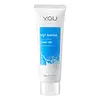What's inside
What's inside
 Key Ingredients
Key Ingredients

 Benefits
Benefits

 Concerns
Concerns

 Ingredients Side-by-side
Ingredients Side-by-side

Water
Skin ConditioningCocamidopropyl Betaine
CleansingPEG-90 Glyceryl Isostearate
CleansingSodium Laureth Sulfate
CleansingGlycerin
HumectantSodium Chloride
MaskingSodium Methyl Cocoyl Taurate
CleansingPhenoxyethanol
PreservativeLaureth-2
CleansingMethylparaben
PreservativeNiacinamide
SmoothingButylene Glycol
HumectantEthylhexylglycerin
Skin ConditioningPropylene Glycol
HumectantCentella Asiatica Extract
CleansingCaprylic/Capric Triglyceride
MaskingHydrogenated Lecithin
EmulsifyingHexylene Glycol
EmulsifyingStearic Acid
CleansingCholesterol
EmollientCeramide NP
Skin ConditioningWater, Cocamidopropyl Betaine, PEG-90 Glyceryl Isostearate, Sodium Laureth Sulfate, Glycerin, Sodium Chloride, Sodium Methyl Cocoyl Taurate, Phenoxyethanol, Laureth-2, Methylparaben, Niacinamide, Butylene Glycol, Ethylhexylglycerin, Propylene Glycol, Centella Asiatica Extract, Caprylic/Capric Triglyceride, Hydrogenated Lecithin, Hexylene Glycol, Stearic Acid, Cholesterol, Ceramide NP
Water
Skin ConditioningSodium Laureth Sulfate
CleansingCocamidopropyl Betaine
CleansingSodium Lauryl Sulfate
CleansingSekken Soji
CleansingSodium Chloride
MaskingGlycol Distearate
EmollientDecyl Glucoside
CleansingPotassium Laureth Phosphate
EmulsifyingDistearyl Phthalic Acid Amide
EmollientPhenoxyethanol
PreservativeSodium Benzoate
MaskingCocamide Mea
EmulsifyingAcrylates Copolymer
PEG-120 Methyl Glucose Dioleate
EmulsifyingPEG-40 Hydrogenated Castor Oil
EmulsifyingGlycerin
HumectantCitric Acid
BufferingMentha Arvensis Leaf Oil
MaskingDisodium EDTA
Butylene Glycol
HumectantHyaluronic Acid
HumectantSalicylic Acid
MaskingGlycolic Acid
BufferingVolcanic Soil
Skin ConditioningPentylene Glycol
Skin ConditioningMoringa Oleifera Seed Extract
Skin ConditioningHistidine
HumectantSerine
MaskingAspartic Acid
MaskingThreonine
Sodium Acetylated Hyaluronate
HumectantSodium Hyaluronate
Humectant1,2-Hexanediol
Skin ConditioningSodium Hyaluronate Crosspolymer
HumectantHydroxyacetophenone
AntioxidantHydrolyzed Sodium Hyaluronate
Skin ConditioningEthylhexylglycerin
Skin ConditioningCI 42090
Cosmetic ColorantWater, Sodium Laureth Sulfate, Cocamidopropyl Betaine, Sodium Lauryl Sulfate, Sekken Soji, Sodium Chloride, Glycol Distearate, Decyl Glucoside, Potassium Laureth Phosphate, Distearyl Phthalic Acid Amide, Phenoxyethanol, Sodium Benzoate, Cocamide Mea, Acrylates Copolymer, PEG-120 Methyl Glucose Dioleate, PEG-40 Hydrogenated Castor Oil, Glycerin, Citric Acid, Mentha Arvensis Leaf Oil, Disodium EDTA, Butylene Glycol, Hyaluronic Acid, Salicylic Acid, Glycolic Acid, Volcanic Soil, Pentylene Glycol, Moringa Oleifera Seed Extract, Histidine, Serine, Aspartic Acid, Threonine, Sodium Acetylated Hyaluronate, Sodium Hyaluronate, 1,2-Hexanediol, Sodium Hyaluronate Crosspolymer, Hydroxyacetophenone, Hydrolyzed Sodium Hyaluronate, Ethylhexylglycerin, CI 42090
Ingredients Explained
These ingredients are found in both products.
Ingredients higher up in an ingredient list are typically present in a larger amount.
Butylene Glycol (or BG) is used within cosmetic products for a few different reasons:
Overall, Butylene Glycol is a safe and well-rounded ingredient that works well with other ingredients.
Though this ingredient works well with most skin types, some people with sensitive skin may experience a reaction such as allergic rashes, closed comedones, or itchiness.
Learn more about Butylene GlycolCocamidopropyl Betaine is a fatty acid created by mixing similar compounds in coconut oil and dimethylaminopropylamine, a compound with two amino groups.
This ingredient is a surfactant and cleanser. It helps gather the dirt, pollutants, and other impurities in your skin to be washed away. It also helps thicken a product and make the texture more creamy.
Being created from coconut oil means Cocamidopropyl Betaine is hydrating for the skin.
While Cocamidopropyl Betaine was believed to be an allergen, a study from 2012 disproved this. It found two compounds in unpure Cocamidopropyl Betaine to be the irritants: aminoamide and 3-dimethylaminopropylamine. High-grade and pure Cocamidopropyl Betaine did not induce allergic reactions during this study.
Learn more about Cocamidopropyl BetaineEthylhexylglycerin (we can't pronounce this either) is commonly used as a preservative and skin softener. It is derived from glyceryl.
You might see Ethylhexylglycerin often paired with other preservatives such as phenoxyethanol. Ethylhexylglycerin has been found to increase the effectiveness of these other preservatives.
Glycerin is already naturally found in your skin. It helps moisturize and protect your skin.
A study from 2016 found glycerin to be more effective as a humectant than AHAs and hyaluronic acid.
As a humectant, it helps the skin stay hydrated by pulling moisture to your skin. The low molecular weight of glycerin allows it to pull moisture into the deeper layers of your skin.
Hydrated skin improves your skin barrier; Your skin barrier helps protect against irritants and bacteria.
Glycerin has also been found to have antimicrobial and antiviral properties. Due to these properties, glycerin is often used in wound and burn treatments.
In cosmetics, glycerin is usually derived from plants such as soybean or palm. However, it can also be sourced from animals, such as tallow or animal fat.
This ingredient is organic, colorless, odorless, and non-toxic.
Glycerin is the name for this ingredient in American English. British English uses Glycerol/Glycerine.
Learn more about GlycerinPhenoxyethanol is a preservative that has germicide, antimicrobial, and aromatic properties. Studies show that phenoxyethanol can prevent microbial growth. By itself, it has a scent that is similar to that of a rose.
It's often used in formulations along with Caprylyl Glycol to preserve the shelf life of products.
Chances are, you eat sodium chloride every day. Sodium Chloride is also known as table salt.
This ingredient has many purposes in skincare: thickener, emulsifier, and exfoliator.
You'll most likely find this ingredient in cleansers where it is used to create a gel-like texture. As an emulsifier, it also prevents ingredients from separating.
There is much debate on whether this ingredient is comedogenic. The short answer - comedogenic ratings don't tell the whole story. Learn more about comegodenic ratings here.
The concensus about this ingredient causing acne seems to be divided. Research is needed to understand if this ingredient does cause acne.
Scrubs may use salt as the primary exfoliating ingredient.
Learn more about Sodium ChlorideSodium Laureth Sulfate (SLES) is a foaming, cleansing, and emulsifying ingredient. It is created from palm kernel oil or coconut oil. SLES is not the same as sodium lauryl sulfate. It is much milder and less likely to irritate.
SLES helps create foam in personal products. It also prevents ingredients from separating, helping to elongate the shelf life.
Sodium Laureth Sulfate is a type of sulfate. It can be drying. We recommend speaking with a professional about using this ingredient if you have concerns.
Learn more about Sodium Laureth SulfateWater. It's the most common cosmetic ingredient of all. You'll usually see it at the top of ingredient lists, meaning that it makes up the largest part of the product.
So why is it so popular? Water most often acts as a solvent - this means that it helps dissolve other ingredients into the formulation.
You'll also recognize water as that liquid we all need to stay alive. If you see this, drink a glass of water. Stay hydrated!
Learn more about Water